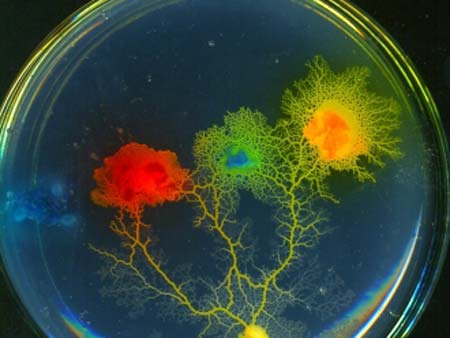Accompanying Art Laboratory's programme of events (DIY Bio Lounge), this
installation displays the bioluminescent bacteria (Aliivibrio fischeri).
These bacteria are widespread in all oceans, and prefer to live in symbiosis
with marine organisms. Bioluminescence, chemical
reactions within the bacterial cells, make these cells visible in the
dark.
The
Aesthetics of Decay
We find the process of decay in organic matter during almost every moment of our lives. Food spoils, flowers wither, living things die. Foods that have intentionally been left to decay, so as to drive up prices, are an expression of a capitalised world whose excesses are an extreme caricature of man's claim to be a social being. However, decay sometimes involves a unique aesthetic - when organic matter decomposes it often leads to a phenomenon - phosphorescence - which appears as a magical glow. Whoever has walked in the twilight through an intact forest, may have encountered this greenish shimmer, and can understand how early cultures, with their own "knowledge", believed in gates to another world.
Another naturally luminous phenomenon is bioluminescence. In contrast to phosphorescence it is produced by living organisms - bacteria. Aliivibrio fischeri, the official name of these bacteria, usually live in symbiosis with marine organisms. To isolate it from other organisms provides a bridge between decomposition and survival. A popular and simple experiment is to place a fresh (green) herring in a 3% salt solution in a refrigerator for about 3 days. After this time, small, dark, turquoise glowing spots show up on the skin of the fish - Aliiibrio fischeri . Another possibility, which was also used for this installation, is the isolation of Aliivibrio fischeri from squid. For this, the ink bladder, and possibly a portion of the intestines, are used as a nutrient medium. After two to three days glowing bacteria can be transferred onto culture medium in order to be further isolated.
By providing the decay of food as a prerequisite for obtaining the life forms, which are also the art medium here titled "Food Question", we would like to draw attention to real, existing, but currently (still) unnecessary food shortages. Future generations will need to access new resources to sustainably feed a growing world population. All people on the planet can still have access to sufficient available food, but we can no longer close our eyes to millions of tonnes of grains which are deliberately left to decay in order to artificially drive up prices. Food is a basic need for all living beings, not something to be speculated on for maximum profits!
(text by the artists )
Jessica Bernds holds a Diploma in Biology and is a "free time artist". She got introduced to the DIY Biology movement in 2012 and is now part of the evolving and growing Berling DIY Bio group. Her interests are set between science and art. Focusing on the scientific part she likes using arts to introduce the scientific facts to a larger audience.
Sarah Chareza completed her PhD in Microbiology and Virology at the Germany Cancer Research Center in Heidelberg and is currently working in a contract research organisation.
























